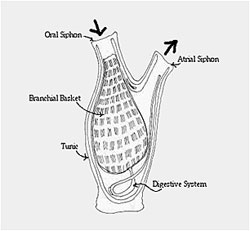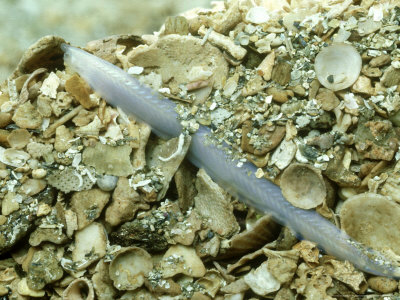1. Notochord (gerinchúr): semi-rigid, rod-like, can be lost or replaced by vertebra
2. Dorsal nerve tube: bundle of nerves in a fluid-filled canal, it lies above the notochord. In vertebrates it develops into the spinal cord and brain (tubular nervous system - csőidegrendszer)
3. gill slits (kopoltyú rés): these either remain, develop further or close up in early development.
4. muscle blocks: modified body segments, attached to the internal skeleton
 |
6. coelom
7. closed circulation
8. deuterostome
9. tail
Classification
3 sub-phyla: 2 invertebrate - urochordata (farokgerinchúrosok), cephalochordata (fejgerinchúrosok)
1 vertebrate - vertebrata
Phylum Urochordata (tunicates or sea squirts - tengeri fecskendők)
As adults they are small, tubular and sessile. They are filter-feeders. On the other hand, larva look like tadpoles (ebihalszerű) and have chordate features, which are lost in the adults
1 vertebrate - vertebrata
Phylum Urochordata (tunicates or sea squirts - tengeri fecskendők)
As adults they are small, tubular and sessile. They are filter-feeders. On the other hand, larva look like tadpoles (ebihalszerű) and have chordate features, which are lost in the adults
 |
 |
| Diagram of an adult tunicate |
 |
| Tunicates |
Phylum Cephalochordata (lancelets - lándzsahal)
About 5cm long, marine organisms. They are fish-shaped and can swim, but they spend lots of time buried in the sand with their head sticking out to filter-feed. They retain their chordate features throughout their lifetime.
 |
Phylum Vertebrata (gerincesek)
- include fish (jawless, cartilaginous and bony), amphibians, reptiles, birds and mammals
Common characteristics
1. Endoskeleton: bony or cartilaginous (porcos), have a backbone made of vertebra (csigolyák), which replaces the notochord in early development, also have a skull and appendages. The advantage of an endoskeleton is that there are many surfaces for muscle attachment and no moulting.
2. Muscle blocks attached to endoskeleton
3. Closed circulatory system
4. Tubular nervous system (csőidegrenszer): brain and spinal cord, complex sense organs
5. Coelom
6. Deuterostomes
7. Bilateral symmetry
Evolution
- water to land
- nervous system: sense organs became more complex, more efficient, brain enlarged, vision and hearing improved
- respiratory organs: gill slits were initially used for filter feeding, then jaws developed from the first pair of gill supports, with transition to land lungs developed, nostrils for breathing
- circulatory system: heart progressively becomes more complex (2 chambers in fish, 3 in amphibians and reptiles, 4 in birds and mammals)
- movement: muscles attached to internal skeleton, paired fins to legs to wings
- body temperature: cold-blooded (ectotherm) vs. warm-blooded (endotherm)
- circulatory system: heart progressively becomes more complex (2 chambers in fish, 3 in amphibians and reptiles, 4 in birds and mammals)
- movement: muscles attached to internal skeleton, paired fins to legs to wings
- body temperature: cold-blooded (ectotherm) vs. warm-blooded (endotherm)

No comments:
Post a Comment